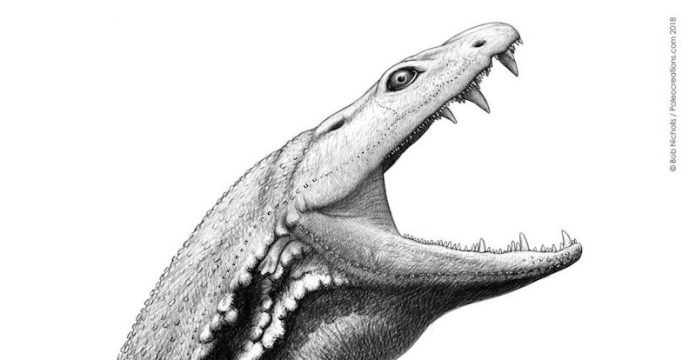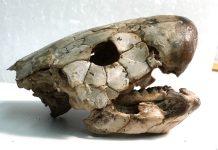
Scientists have used advances in CT scanning and 3D visualization to reconstruct the skull of Crassigyrinus scoticus, an ancient crocodile-like predator that lived over 300 million years ago.
Known as the “tadpole from hell,” Crassigyrinus was well-suited to hunting prey in Carboniferous swamps with its huge teeth, big eyes, and range of sensory adaptations.
However, with all known fossils of the Carboniferous carnivore severely crushed, understanding the species has been challenging.
Using CT scans from four Crassigyrinus specimens, the team was able to identify all of the bones of the skull and rebuild the tetrapod’s skull like a 3D-jigsaw puzzle.
The reconstructed skull is similar in shape to a modern crocodile, and with a powerful bite, Crassigyrinus would have been a fearsome predator, lurking below the surface of the water and using its bite to grab prey.
Specialized senses for tracking prey Crassigyrinus’ skull contains ridges that would have helped to strengthen it and spread the force of its bite between its many teeth.
In addition, it had specialized senses that helped it track prey, such as large eyes to see in dim coal swamps and lateral lines to detect vibrations in the water.
The mysterious gap near the front of its snout may indicate that it had other senses as well.
The gap is much larger than that found in other early tetrapods, with smoothly sculpted edges, and speculation is that it may have housed a rostral organ, which helped detect electric fields, or a Jacobson’s organ, which is found in animals such as snakes and helps detect different chemicals.
The importance of CT scanning and 3D visualization Thanks to CT scanning and 3D visualization, researchers can now piece together the fragments of severely crushed and flattened fossils for the first time.
It provides a better understanding of the appearance and capabilities of ancient creatures like Crassigyrinus.
The process of fossilisation has caused specimens of Crassigyrinus to become compressed, leading to previous incorrect reconstructions of the species.
However, the CT scans from multiple specimens allowed the researchers to rebuild the squashed Crassigyrinus specimen with a good degree of confidence.
Future research Now that the skull has been reconstructed, the team is putting it through biomechanical simulations to determine what Crassigyrinus was capable of.
By studying the structure and movements of the reconstructed skull, scientists can gain insights into how Crassigyrinus hunted and how it lived.
As technology continues to advance, we may learn more about the sensory adaptations and hunting techniques of ancient creatures like Crassigyrinus, providing new information on the evolution of life on Earth.
The study was published in the Journal of Vertebrate Paleontology.
Copyright © 2023 Knowridge Science Report. All rights reserved.



